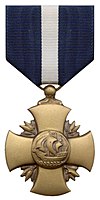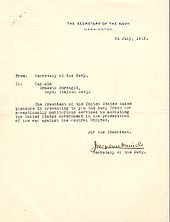Navy Cross
| Navy Cross | |
|---|---|

|
|
| Awarded by the Department of the Navy | |
| Art | medal |
| requirement | Members of the American armed forces, as well as soldiers of allied forces and civilians. |
| Awarded for | striking heroism |
| status | Is awarded |
| Data | |
| Foundation year | 1917 (officially 1919) |
| First awarded | 1919 |
| Last award | August 10, 2012 |
| Awards | 6,924 (as of 2008) |
| Precedence | |
| Next lower award | Distinguished Service Medals : Defense, Homeland Security, Army, Navy, Air Force, Coast Guard |

|
|
The Navy Cross is the highest honor awarded by the Department of the Navy . It ranks immediately behind the Medal of Honor in the Pyramid of Honor ranking . This medal is given not only to members of the United States Navy , Marine Corps and the Coast Guard , but also to those of the Army and the Air Force , as well as to soldiers of allied forces and to civilians who are on a mission with the US Navy or to the US Marine Corps for outstanding valor.
history
The Navy Cross was officially introduced on February 4, 1919 with a law resolution (Public Law 253, 65th Congress) of the US Congress , although it has been awarded since April 1917.
The medal created by James Earl Fraser (1876-1953) was originally the third highest award in the Navy after the Medal of Honor and the Navy Distinguished Service Medal . It was not until a congressional resolution of August 7, 1942 that this order was upgraded to its current status. Since then, the Navy Cross has been worn on uniforms after the Medal of Honor and thus before all other awards. It is equivalent to the Distinguished Service Cross (Army) and Air Force Cross (Air Force).
Another government resolution of August 7, 1942 stipulated that only services rendered in the event of war may be recognized with this award.
Description and symbolism
front
The cross has a diameter of 1.5 inches (≈ 3.8 cm) and is rounded at the ends of the beam, compared to conventional crosses with a straight end. Between the bars there is a bay leaf with berries. In the center of the cross itself there is a sailing ship bedded on waves, traveling to the left, if you look directly at the front. The ship itself is a caravel , a type of ship that was used by the Western European sea powers in the 15th and 16th centuries . James Earl Fraser chose the caravel because it is a symbol of the discovery of America and the naval tradition of the US Navy at the Naval Academy . The laurel leaves on the medal symbolize the achievement.
back
The back of the Navy Cross is decorated with crossed anchors with a corresponding chain , as they were often used before 1850 . At the intersection of the anchors are the initials USN , which means United States Navy .
tape
The ribbon is blue with a white stripe in the middle . Blue stands for service in the US Navy , while white in its purity embodies the selflessness of achievement.
Additional awards
In the case of multiple awards with the Navy Cross, each of the second to fifth awards are marked by gold stars with a diameter of 5/16 In (≈ 0.8 cm) on the ribbon buckle and on the ribbon of the medal. For the sixth award, a gold star should be replaced by a silver star, which indicates a sixth award. To date, nobody has received more than five awards. Rear Admiral Roy M. Davenport and USMC Lieutenant General Lewis B. Puller each received the Navy Cross five times.
Criteria for the award
The medal is awarded to personnel of the Navy, the Marine Corps or the Coast Guard, as well as to soldiers of the allied armed forces and civilians who have distinguished themselves through special bravery in combat but do not deserve the Medal of Honor . The award can only be given because of one of the following three circumstances:
- During a mission against enemies of the United States of America .
- During a military mission in which there is a clash with a foreign power.
- During an operation with a friendly nation that is in armed conflict with another power, the United States not being one of the powers involved in the fight.
In order to earn the Navy Cross, the respective act must take place in the face of greatest danger or high expected losses, and must be viewed in such a way that the bravery rendered must not be assessed on the basis of the rank or on the basis of previous combat experience. The decisive factor is only one outstanding action and not a large number of previous achievements.
First recipient
The first awards of the Navy Cross are unknown, as they came about on the basis of a lengthy list published after the First World War .
Scout Sniper Marine Sergeant Matthew T. Abbate was one of the final recipients of the Navy Cross. He received the award posthumously on August 10, 2012 from United States Secretary of the Navy Ray Mabus for his services during an ambush patrol October 14, 2010 in Sangin, Afghanistan . Abbate was killed in action on December 2, 2010 in Helmand (province) , Afghanistan.

Over one hundred non-US citizens have been awarded the Navy Cross. These included two submarine commanders from the Soviet Union in World War II and two South Vietnamese in the Vietnam War .
Known porters
Web links
Individual evidence
- ↑ The Navy Cross Online ( Memento of the original from July 16, 2012 in the Internet Archive ) Info: The archive link was automatically inserted and not yet checked. Please check the original and archive link according to the instructions and then remove this notice.
- ↑ Scout Sniper posthumously awarded Navy Cross . marines.mil, accessed August 21, 2012
